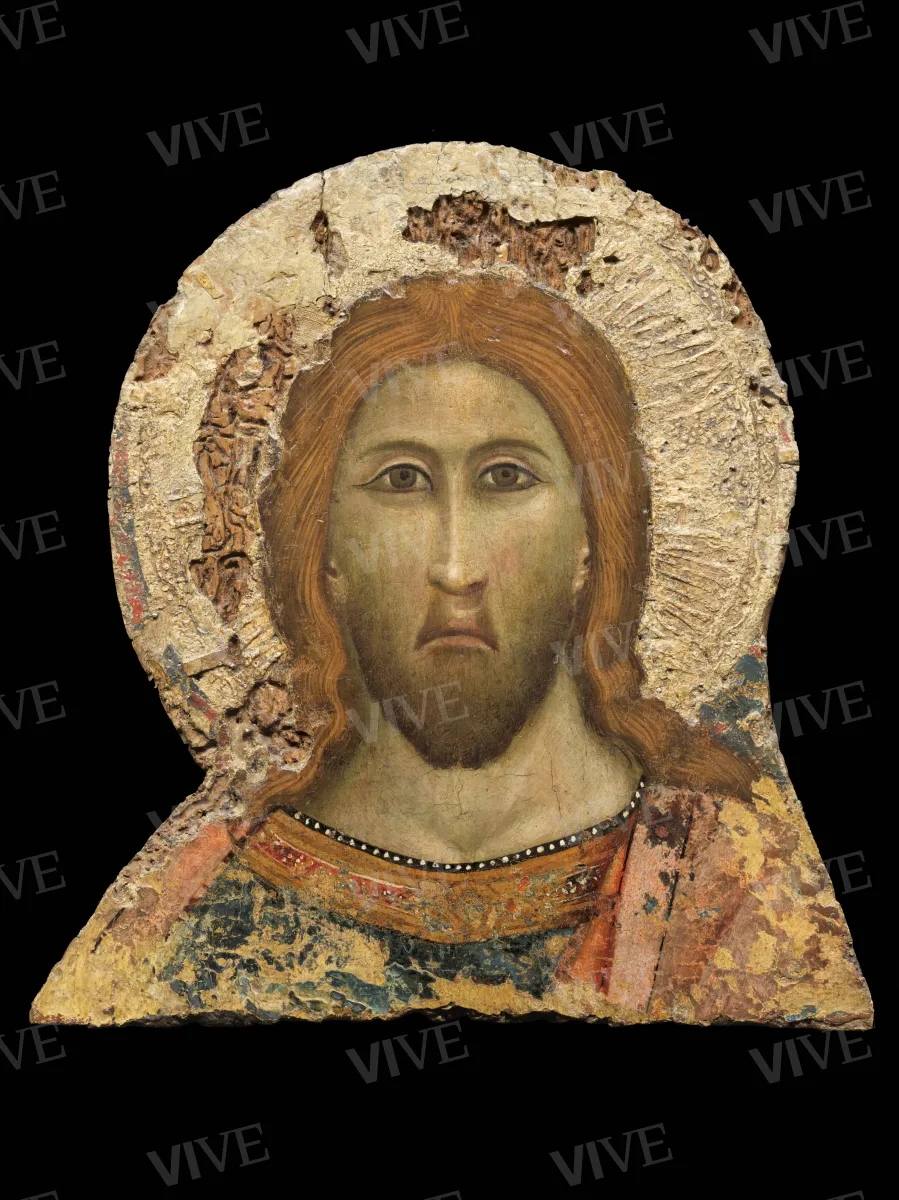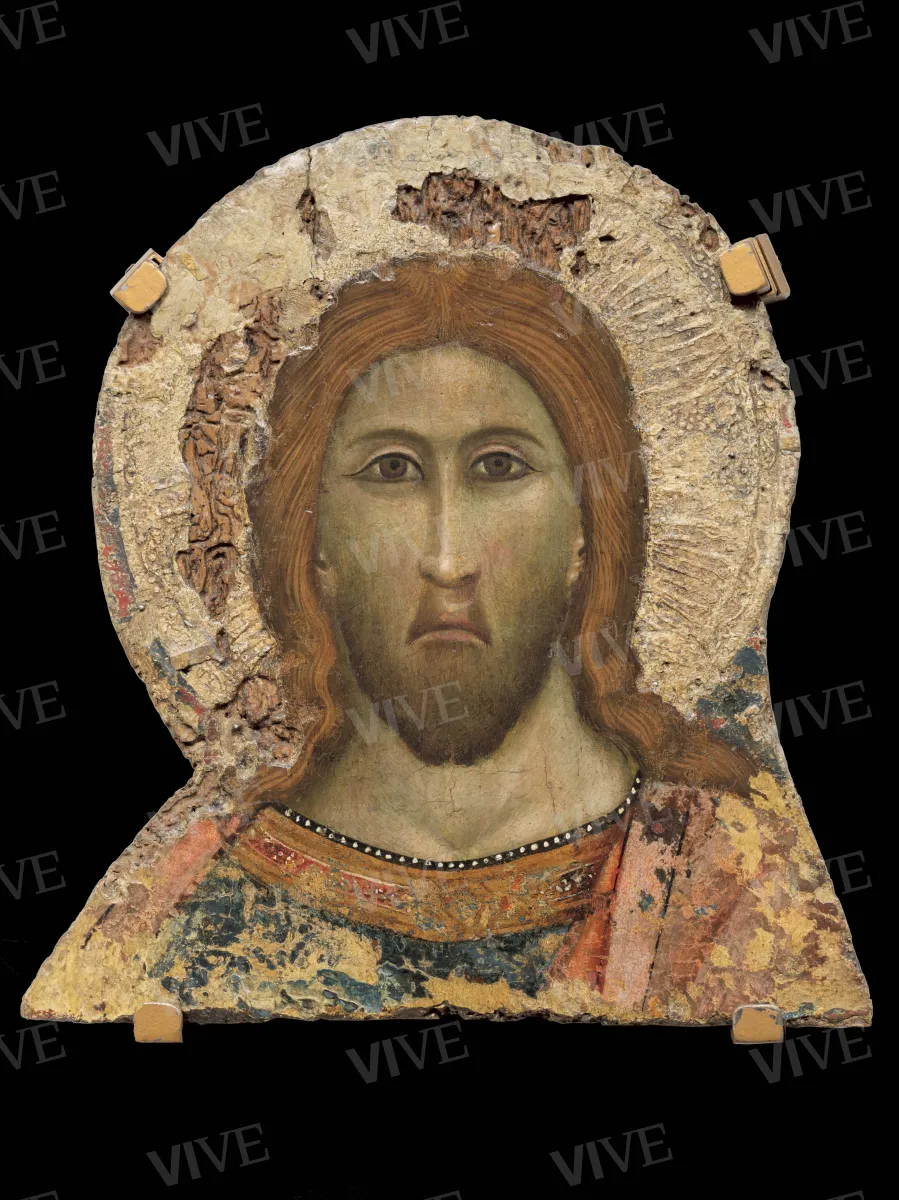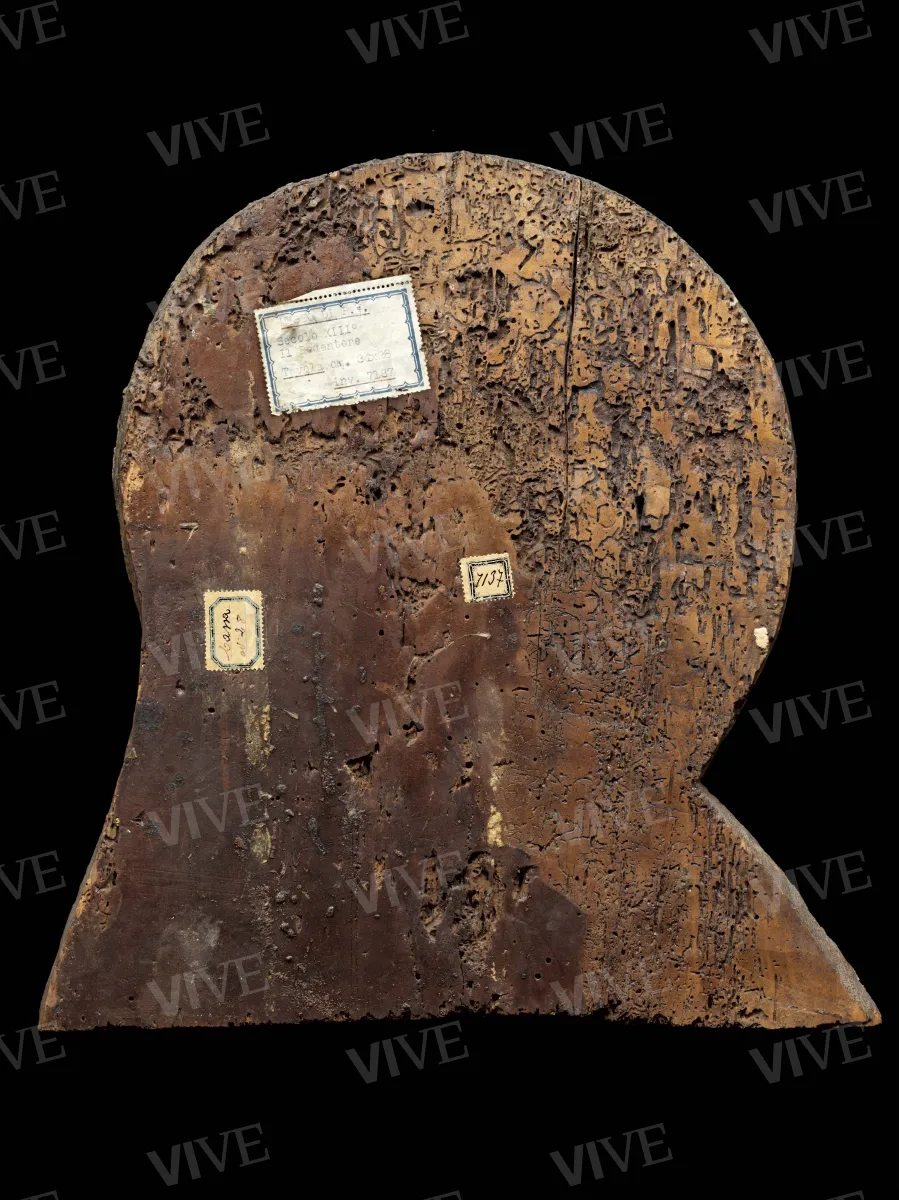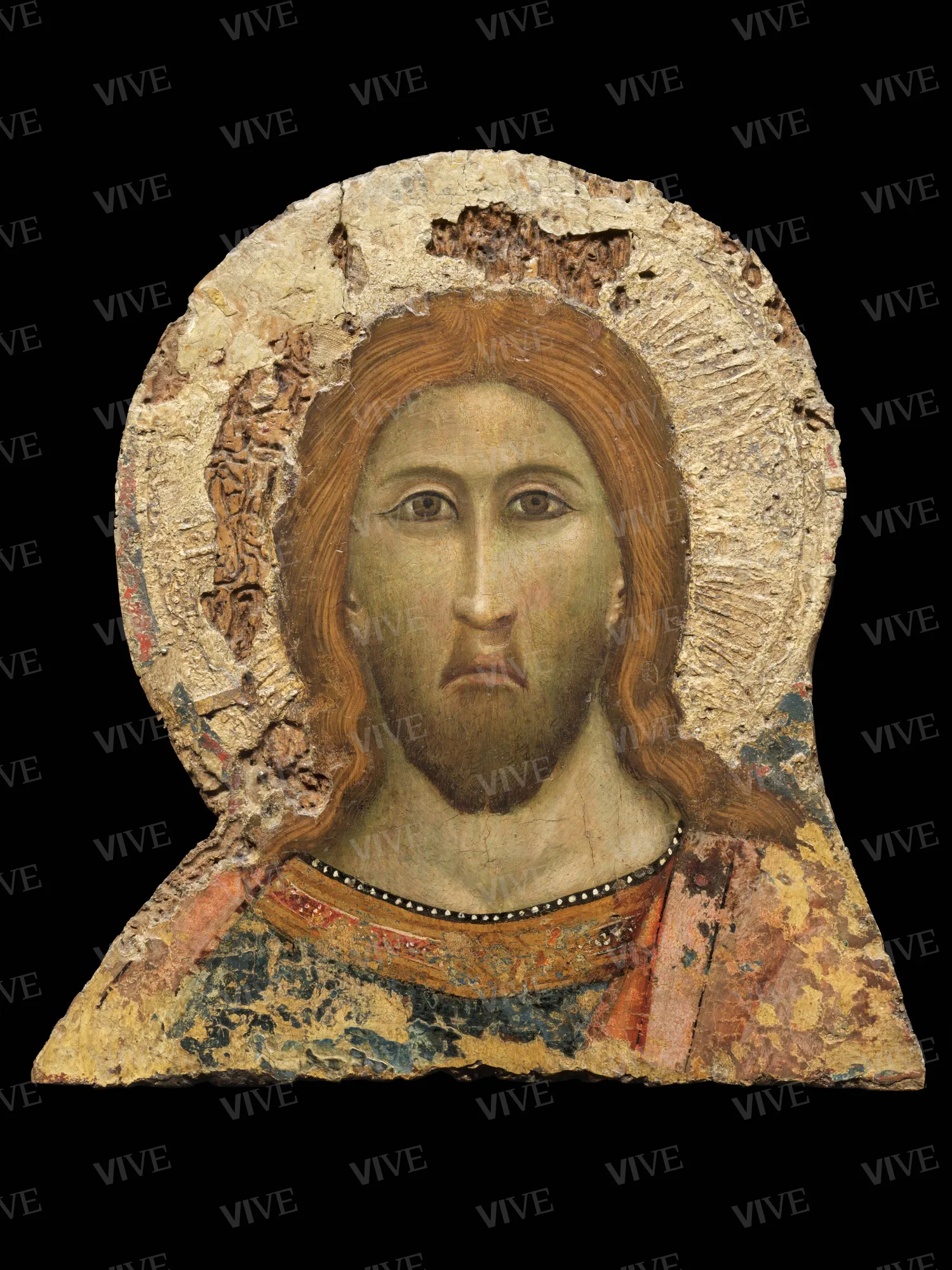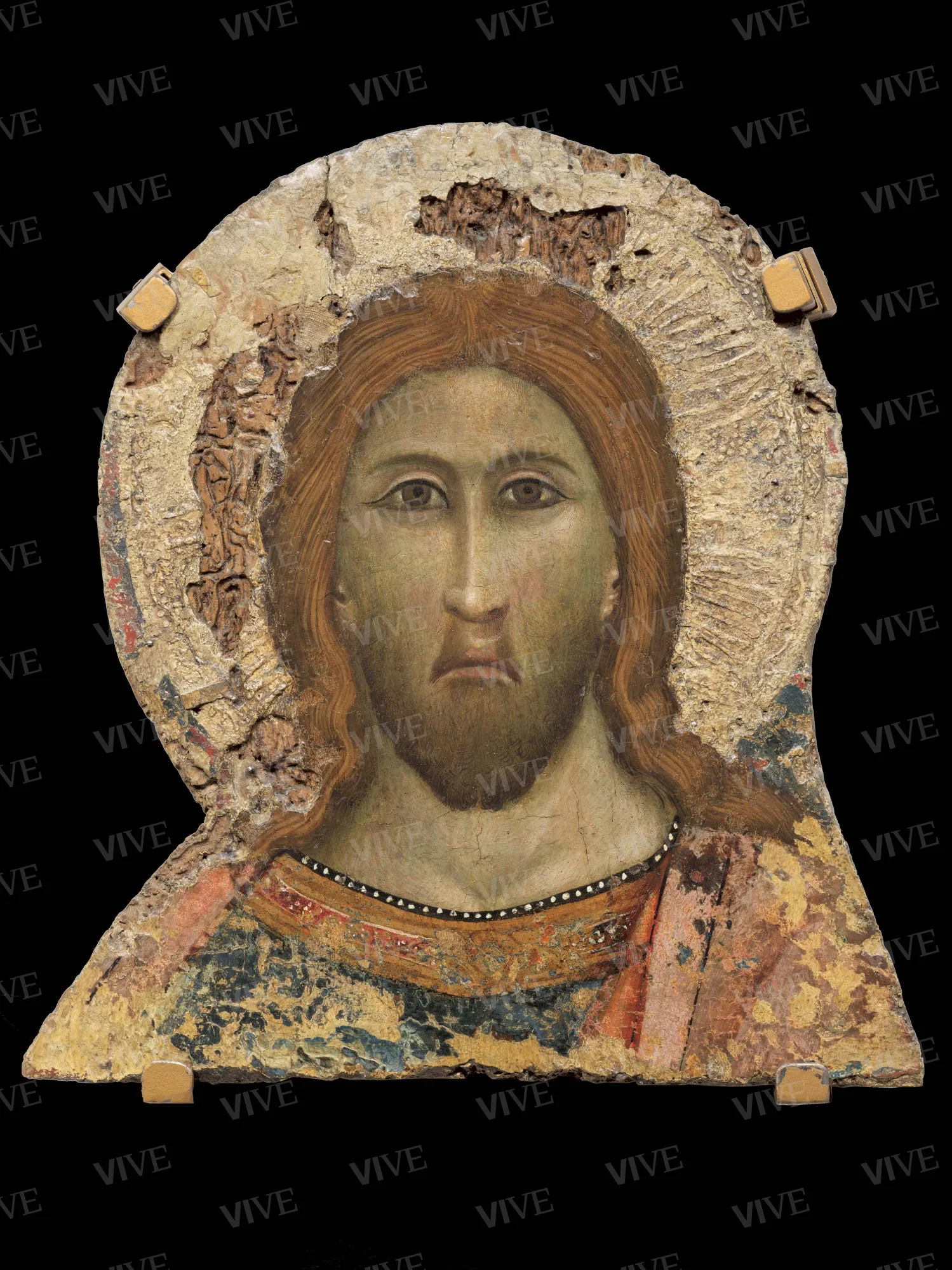Head of the Redeemer
Circle of Pietro Cavallini Late-13th–early-14th century
Originally part of a larger work, the panel depicts, on a blue background of which few traces remain, the head of the Redeemer, with a halo in gold leaf that has largely disappeared; the hair is well defined in locks and falls over the shoulders, forming soft undulations over the shoulders; the elongated, frontal face is bearded. The features are carefully rendered and well delineated despite the loss of the elements depicting the Redeemer’s complexion, in a grayish tone. The torso is covered by a blue robe, which ends in a border with a faux-embroidered sash and decorated with minute beading.
Originally part of a larger work, the panel depicts, on a blue background of which few traces remain, the head of the Redeemer, with a halo in gold leaf that has largely disappeared; the hair is well defined in locks and falls over the shoulders, forming soft undulations over the shoulders; the elongated, frontal face is bearded. The features are carefully rendered and well delineated despite the loss of the elements depicting the Redeemer’s complexion, in a grayish tone. The torso is covered by a blue robe, which ends in a border with a faux-embroidered sash and decorated with minute beading.
Details of work
Catalog entry
The origin of the painting, which was certainly part of a larger work, is unknown. When it was acquired by Palazzo Venezia in 1935, it was completely repainted and reinserted into a larger panel (about 60x40 cm) that was then removed during subsequent restoration. There are various opinions about the nature of the latter: a Maiestas Domini (Tomei 2000, 144; Tartuferi 2004, 78) inspired by the Savior of the Sancta Sanctorum or perhaps a Last Judgment or, again, the cymatium of a painted cross (Morozzi 2000, 189). The work was attributed to Pietro Cavallini himself by Boskovits (1983, 303); more likely, it is the work of a close collaborator of the Roman master Cavallini (Tomei 1984, 324–325; Gandolfo 1988; Morozzi 2000, 190; Tomei 2000, 144–145), who might be (see Bellosi 2000, 213) the so-called Master of the Altieri Madonna, in a private collection.
Stefania Paone
Entry published on 12 February 2025
State of conservation
Fair. The face of the Redeemer is well legible and has minimal rigatino additions, while the halo has lost much of its gilding. A few areas are missing on the red mantle and, to a greater extent on the blue robe, executed in lapis lazuli. The wood shows very old damage caused by woodworm.
Restorations and analyses
After its purchase in 1935, the painting was removed from the wooden support in which it had been placed at an unspecified time. In 1973, work was done to repair the missing elements that affected small areas of the face and, to a greater extent, the robe. The wax that covered the surface and the gilding of the halo afterimage were removed; the wooden support, which had been attacked by woodworm, was restored and consolidated. A report of the restoration carried out by Nerina Angelini, under the direction of Giovanni Carandente, is preserved in the museum archives.
Provenance
Maria Sagretti Manzi collection.
Exhibition history
Rome, Palazzo Venezia, L’arte degli anni santi. Roma 1300-1875, 20 December 1984–5 April 1985;
Rome, Palazzo Venezia, Romei & giubilei: il pellegrinaggio medievale a San Pietro (350-1350), 29 October 1999–26 February 2000, n. 223;
Rome, Palazzo di Venezia, Bonifacio VIII e il suo tempo, 12 April–16 July 2000;
Rome, Musei Capitolini, Dipinti romani tra Giotto e Cavallini, 8 April–29 June 2004;
Rimini, Castel Sismondo, EXEMPLA. La rinascita dell’Antico nell’arte italiana, 20 April–7 September 2008;
Rome, Complesso del Vittoriano, Giotto e il Trecento. “Il più sovrano maestro stato in dipintura”, 6 March–29 June 2009.
References
Matthiae Guglielmo, Tavoletta del Redentore di Palazzo Venezia, in «Studi Romani», 22 (1974), 472-474;
Boskovits Miklòs, Proposte (e conferme) per Pietro Cavallini, in Romanini Angiola Maria (a cura di), Roma Anno 1300, Atti della IV Settimana di Studi di Storia dell'arte medievale dell'Univ. di Roma La Sapienza (1980), Roma 1983, pp. 297-329;
Tomei Alessandro, VII.6, Testa del Redentore, in Fagiolo Marcello, Madonna Maria Luisa (a cura di), L’arte degli anni santi. Roma 1300-1875, catalogo dell mostra (Roma, Palazzo Venezia, 20 dicembre 1984-5 aprile 1985), Milano 1984, pp. 324-325;
Gandolfo Francesco, aggiornamento a Matthiae Guglielmo, Pittura romana del Medioevo. Secoli XI-XIV, Roma 1988, p. 334;
Luciano, in Tartuferi Angelo (a cura di), Giotto. Bilancio critico di sessant’anni di studi e ricerche, catalogo della mostra (Firenze, Galleria dell'Accademia, 5 giugno-30 settembre 2000), Firenze 2000, pp. 121-123, n. 7;
Tomei Alessandro, Pietro Cavallini, Cinisello Balsamo 2000, pp. 144-145;
Morozzi, in Righetti Tosti-Croce Marina (a cura di), Bonifacio VIII e il suo tempo, Anno 1300 il primo giubileo, catalogo della mostra (Roma, Palazzo Venezia, 12 aprile-16 luglio 2000), Milano 2000, pp. 189-190, n. 158;
Tartuferi, in Strinati Tommaso, Tartuferi Angelo (a cura di), Dipinti romani tra Giotto e Cavallini, catalogo della mostra (Roma, Musei Capitolini, 8 aprile-29 giugno 2004), Milano 2004, pp. 78-79, n. 10;
Tarantelli, in Tomei Alessandro (a cura di), Giotto e il Trecento. "Il più Sovrano Maestro stato in dipintura", catalogo della mostra (Roma, Complesso del Vittoriano, 6 marzo-29 giugno 2009), Milano 2009, p. 178, n. 21;
Schmitz Michael, Pietro Cavallini in Santa Cecilia in Trastevere: ein Beitrag zur römischen Malerei des Due und Trecento (Römische Studien der Bibliotheca Hertziana 33), München 2013, pp. 41, 44, 160;
Sgherri Daniela, Il Salvatore nel Museo di Palazzo Venezia, in La pittura medievale a Roma. Corpus, VI. Apogeo e fine del Medioevo. 1288-1431, a cura di Romano Serena, Milano 2017, pp. 226-227.

